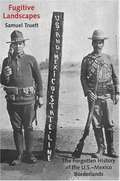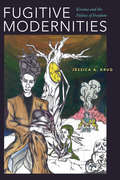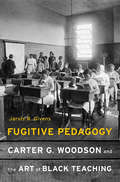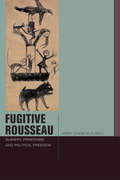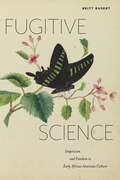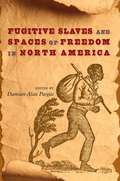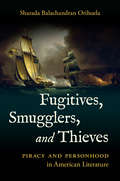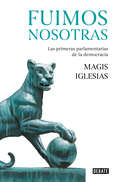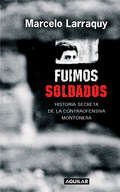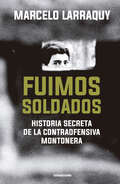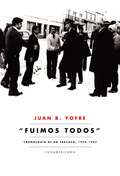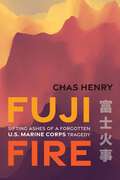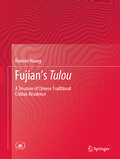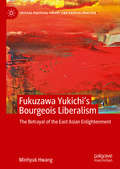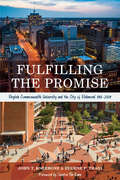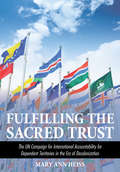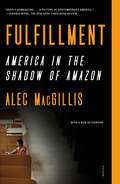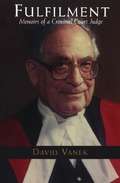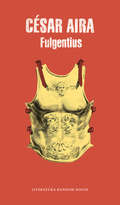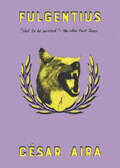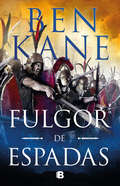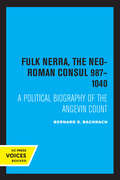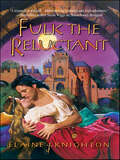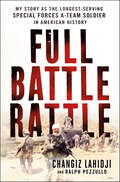- Table View
- List View
Fugitive Landscapes: The Forgotten History of the U.S.-Mexico Borderlands
by Samuel TruettThis book reveals the forgotten story of their ambitious dreams and their ultimate failure to control this fugitive terrain. Focusing on a mining region that spilled across the Arizona--Sonora border, this book shows how entrepreneurs, corporations, and statesmen tried to domesticate nature and society within a transnational context. Efforts to tame a "wild" frontier were stymied by labor struggles, social conflict, and revolution. Fugitive Landscapes explores the making and unmaking of the U. S. -Mexico border, telling how ordinary people resisted the domination of empires, nations, and corporations to shape transnational history on their own terms. By moving beyond traditional national narratives, it offers new lessons for our own border-crossing age.
Fugitive Modernities: Kisama and the Politics of Freedom
by Jessica A. KrugDuring the early seventeenth century, Kisama emerged in West Central Africa (present-day Angola) as communities and an identity for those fleeing expanding states and the violence of the trans-Atlantic slave trade. The fugitives mounted effective resistance to European colonialism despite—or because of—the absence of centralized authority or a common language. In Fugitive Modernities Jessica A. Krug offers a continent- and century-spanning narrative exploring Kisama's intellectual, political, and social histories. Those who became Kisama forged a transnational reputation for resistance, and by refusing to organize their society around warrior identities, they created viable social and political lives beyond the bounds of states and the ruthless market economy of slavery. Krug follows the idea of Kisama to the Americas, where fugitives in the New Kingdom of Grenada (present-day Colombia) and Brazil used it as a means of articulating politics in fugitive slave communities. By tracing the movement of African ideas, rather than African bodies, Krug models new methods for grappling with politics and the past, while showing how the history of Kisama and its legacy as a global symbol of resistance that has evaded state capture offers essential lessons for those working to build new and just societies.
Fugitive Pedagogy: Carter G. Woodson and the Art of Black Teaching
by Jarvis R. GivensA fresh portrayal of one of the architects of the African American intellectual tradition, whose faith in the subversive power of education will inspire teachers and learners today. Black education was a subversive act from its inception. African Americans pursued education through clandestine means, often in defiance of law and custom, even under threat of violence. They developed what Jarvis Givens calls a tradition of “fugitive pedagogy”—a theory and practice of Black education in America. The enslaved learned to read in spite of widespread prohibitions; newly emancipated people braved the dangers of integrating all-White schools and the hardships of building Black schools. Teachers developed covert instructional strategies, creative responses to the persistence of White opposition. From slavery through the Jim Crow era, Black people passed down this educational heritage. There is perhaps no better exemplar of this heritage than Carter G. Woodson—groundbreaking historian, founder of Black History Month, and legendary educator under Jim Crow. Givens shows that Woodson succeeded because of the world of Black teachers to which he belonged: Woodson’s first teachers were his formerly enslaved uncles; he himself taught for nearly thirty years; and he spent his life partnering with educators to transform the lives of Black students. Fugitive Pedagogy chronicles Woodson’s efforts to fight against the “mis-education of the Negro” by helping teachers and students to see themselves and their mission as set apart from an anti-Black world. Teachers, students, families, and communities worked together, using Woodson’s materials and methods as they fought for power in schools and continued the work of fugitive pedagogy. Forged in slavery, embodied by Woodson, this tradition of escape remains essential for teachers and students today.
Fugitive Pieces: A Novel (Vintage International Ser.)
by Anne MichaelsAnne Michaels’ spellbinding début novel has quickly become one of the most beloved and talked-about books of the decade. As a young boy during the Second World War, Jakob Beer is rescued from the mud in Poland by an unlikely saviour, the scientist Athos Roussos, and he is taken to Greece, then, at war’s end, to Toronto. It is here that his loss gradually surfaces, as does the haunting question of his sister’s fate. Later in life, as a translator and a poet, and now with the glorious Michaela, Jakob meets Ben, a young professor whose own legacies of the war kindle within him a fascination with the older man and his writing. Fugitive Pieces is a work of rare vision that is at once lyrical, sensual, profound. With its vivid evocation of landscape and character, its unique excavation of memory and time, it is a wholly unforgettable novel that draws us into the lives of its characters with compassion and recognition.
Fugitive Rousseau: Slavery, Primitivism, and Political Freedom (Just Ideas)
by Jimmy Casas KlausenCritics have claimed that Jean-Jacques Rousseau was a primitivist uncritically preoccupied with “noble savages” and that he remained oblivious to the African slave trade. Fugitive Rousseau presents the emancipatory possibilities of Rousseau’s thought and argues that a fresh, “fugitive” perspective on political freedom is bound up with Rousseau’s treatments of primitivism and slavery.Rather than trace Rousseau’s arguments primarily to the social contract tradition of Hobbes and Locke, Fugitive Rousseau places Rousseau squarely in two imperial contexts: European empire in his contemporary Atlantic world and Roman imperial philosophy. Anyone who aims to understand the implications of Rousseau’s famous sentence “Man is born free, and everywhere he is in chains” or wants to know how Rousseauian arguments can support a radical democratic politics of diversity, discontinuity, and exodus will find Fugitive Rousseau indispensable.
Fugitive Science: Empiricism and Freedom in Early African American Culture (America and the Long 19th Century #10)
by Britt RusertHonorable Mention, 2019 MLA Prize for a First Book Sole Finalist Mention for the 2018 Lora Romero First Book Prize, presented by the American Studies AssociationExposes the influential work of a group of black artists to confront and refute scientific racism. Traversing the archives of early African American literature, performance, and visual culture, Britt Rusert uncovers the dynamic experiments of a group of black writers, artists, and performers. Fugitive Science chronicles a little-known story about race and science in America. While the history of scientific racism in the nineteenth century has been well-documented, there was also a counter-movement of African Americans who worked to refute its claims. Far from rejecting science, these figures were careful readers of antebellum science who linked diverse fields—from astronomy to physiology—to both on-the-ground activism and more speculative forms of knowledge creation. Routinely excluded from institutions of scientific learning and training, they transformed cultural spaces like the page, the stage, the parlor, and even the pulpit into laboratories of knowledge and experimentation. From the recovery of neglected figures like Robert Benjamin Lewis, Hosea Easton, and Sarah Mapps Douglass, to new accounts of Martin Delany, Henry Box Brown, and Frederick Douglass, Fugitive Science makes natural science central to how we understand the origins and development of African American literature and culture. This distinct and pioneering book will spark interest from anyone wishing to learn more on race and society.
Fugitive Slaves and Spaces of Freedom in North America (Southern Dissent)
by Damian Alan PargasThis volume introduces a new way to study the experiences of runaway slaves by defining different “spaces of freedom” they inhabited. It also provides a groundbreaking continental view of fugitive slave migration, moving beyond the usual regional or national approaches to explore locations in Canada, the U.S. North and South, Mexico, and the Caribbean. Using newspapers, advertisements, and new demographic data, contributors show how events like the Revolutionary War and westward expansion shaped the slave experience. Contributors investigate sites of formal freedom, where slavery was abolished and refugees were legally free, to determine the extent to which fugitive slaves experienced freedom in places like Canada while still being subject to racism. In sites of semiformal freedom, as in the northern United States, fugitives’ claims to freedom were precarious because state abolition laws conflicted with federal fugitive slave laws. Contributors show how local committees strategized to interfere with the work of slave catchers to protect refugees. Sites of informal freedom were created within the slaveholding South, where runaways who felt relocating to distant destinations was too risky formed maroon communities or attempted to blend in with free black populations. These individuals procured false documents or changed their names to avoid detection and pass as free. The essays discuss slaves’ motivations for choosing these destinations, the social networks that supported their plans, what it was like to settle in their new societies, and how slave flight impacted broader debates about slavery. This volume redraws the map of escape and emancipation during this period, emphasizing the importance of place in defining the meaning and extent of freedom. Contributors: Kyle Ainsworth | Mekala Audain | Gordon S. Barker | Sylviane A. Diouf | Roy E. Finkenbine | Graham Russell Gao Hodges | Jeffrey R. Kerr-Ritchie | Viola Franziska Müller | James David Nichols | Damian Alan Pargas | Matthew Pinsker A volume in the series Southern Dissent, edited by Stanley Harrold and Randall M. Miller
Fugitives, Smugglers, and Thieves: Piracy and Personhood in American Literature
by Sharada Balachandran OrihuelaIn this book, Sharada Balachandran Orihuela examines property ownership and its connections to citizenship, race and slavery, and piracy as seen through the lens of eighteenth- and nineteenth-century American literature. Balachandran Orihuela defines piracy expansively, from the familiar concept of nautical pirates and robbery in international waters to postrevolutionary counterfeiting, transnational slave escape, and the illegal trade of cotton across the Americas during the Civil War. Weaving together close readings of American, Chicano, and African American literature with political theory, the author shows that piracy, when represented through literature, has imagined more inclusive and democratic communities than were then possible in reality. The author shows that these subjects are not taking part in unlawful acts only for economic gain. Rather, Balachandran Orihuela argues that piracy might, surprisingly, have served as a public good, representing a form of transnational belonging that transcends membership in any one nation-state while also functioning as a surrogate to citizenship through the ownership of property. These transnational and transactional forms of social and economic life allow for a better understanding of the foundational importance of property ownership and its role in the creation of citizenship.
Fuimos nosotras: Las primeras parlamentarias de la democracia
by Magis IglesiasUna apasionante crónica sobre las ignoradas primeras parlamentarias de la democracia española. ¿Quién da voz a las mujeres que tomaron las riendas de la consolidación democrática de nuestro país? <P><P>En cuatro décadas de vida que cuenta ya la Constitución Española de 1978, mucho es el material que encontramos en relación a los parlamentarios constituyentes, padres de la Constitución o ponentes de la carta Magna. <P><P>Sin embargo, si en algo resultó revolucionaria la democracia española fue en el cambio que supuso para las mujeres. Un cambio impulsado por la presencia y la actividad de extraordinarias mujeres parlamentarias que abrieron las compuertas de un embalse que ha alimentado ríos de libertad para todas las españolas. <P><P>Ahora más que nunca, la sociedad en su conjunto necesita modelos y referentes de mujeres que hicieron historia y fueron pioneras en el ejercicio del poder político de la democracia: mujeres que dejaron huella. Con esta obra eminentemente periodística, Magis Iglesias pretende seguir esa huella, sacarla a la luz y promocionarla ampliamente mediante un relato biográfico de las desconocidas madres de la Constitución.
Fuimos soldados
by Marcelo LarraquyHistoria secreta de la contraofensiva montonera. Después de las exitosas obras Galimberti y López Rega, Marcelo Larraquy reconstruye las historias de ese puñado de hombres y mujeres a los que se reconoce como desaparecidos pero no como soldados, y a quienes la manipulación política dejó afuera del canon de la memoria setentista. Lazarte, un combatiente rebelde, expulsado de la guerrilla montonera, quiere matar a los miembros de la Conducción, a quienes responsabiliza por la desaparición de su hermana durante la dictadura militar. Para cumplir con su plan, necesita ser reincorporado y recuperar la confianza de los dirigentes. Se ofrece entonces para realizar una acción heroica, a la que difícilmente pueda sobrevivir: volver a la Argentina para interferir las emisiones televisivas de los partidos del Mundial '78 y propagar el discurso del comandante montonero Mario Firmenich. Contra todos los pronósticos, Lazarte alcanza su objetivo. De regreso en México, Montoneros lo readmite en sus filas y lo pone al frente de un pelotón de soldados con el que viaja nuevamente al país a cumplir otra misión peligrosa. El pelotón cruza la frontera con identidades fraguadas e intenta sobrevivir en la clandestinidad. Le faltan armas y dinero; algunos soldados desertan, otros desaparecen, pero el grupo tiene objetivos para cumplir, y Lazarte no olvida el suyo. Como ellos, otros combatientes montoneros tomaron las armas y regresaron al país entre 1978 y 1980 para combatir a la dictadura militar, mientras la sociedad festejaba en las calles los triunfos futbolísticos de esos años. Casi ninguno sobrevivió.
Fuimos soldados (Edición 2021): Historia secreta de la contraofensiva montonera
by Marcelo LarraquyDespués de las exitosas obras Galimberti y López Rega, Marcelo Larraquy reconstruye las historias de ese puñado de hombres y mujeres a los que se reconoce como desaparecidos pero no como soldados, y a quienes la manipulación política dejó afuera del canon de la memoria setentista. Lazarte, un combatiente rebelde, expulsado de la guerrilla montonera, quiere matar a los miembros de la Conducción, a quienes responsabiliza por la desaparición de su hermana durante la dictadura militar. Para cumplir con su plan, necesita ser reincorporado y recuperar la confianza de los dirigentes. Se ofrece entonces para realizar una acción heroica, a la que difícilmente pueda sobrevivir: volver a la Argentina para interferir las emisiones televisivas de los partidos del Mundial '78 y propagar el discurso del comandante montonero Mario Firmenich. Contra todos los pronósticos, Lazarte alcanza su objetivo. De regreso en México, Montoneros lo readmite en sus filas y lo pone al frente de un pelotón de soldados con el que viaja nuevamente al país a cumplir otra misión peligrosa. El pelotón cruza la frontera con identidades fraguadas e intenta sobrevivir en la clandestinidad. Le faltan armas y dinero; algunos soldados desertan, otros desaparecen, pero el grupo tiene objetivos para cumplir, y Lazarte no olvida el suyo. Como ellos, otros combatientes montoneros tomaron las armas y regresaron al país entre 1978 y 1980 para combatir a la dictadura militar, mientras la sociedad festejaba en las calles los triunfos futbolísticos de esos años. Casi ninguno sobrevivió.
Fuimos todos: Cronología de un fracaso 1976-1983
by Juan B. YofreContinuación de «Nadie fue», se centra entre los años de la dictadurahasta la guerra de Malvinas y sus consecuencias. «Nadie fue», el libro anterior de Juan B. Yofre, se convirtió en una delas grandes sorpresas editoriales de los últimos años. Sobre la base defuentes privilegiadas, narraba el desarrollo histórico de la Argentinade los años 70 hasta la caída de Isabel Perón. «Fuimos todos» es lafascinante continuación de aquel éxito: retoma los avatares de nuestrahistoria desde el 24 de marzo de 1976 hasta la aventura militar deMalvinas -que llevó al fin del Proceso- y sus consecuencias. Yofrerepite aquí su procedimiento periodístico, exhuma documentos, apuntes,informes, cartas, que ven la luz por primera vez. Hallazgos que muestranaspectos absolutamente desconocidos de un período de violencia y dancuenta del enfrentamiento entre los argentinos, ya no solamente de lasFuerzas Armadas y las organizaciones terroristas sino también de lascontinuas luchas intestinas del propio régimen castrense. Un eslabón másen la historia de la decadencia política argentina. Exhaustivamentedocumentado, polémico, revelador, Fuimos todos expone los hechos, comodice el autor, "sine ira et cum studio", es decir, para que el lectorsaque sus propias conclusiones y con la honesta intención de evitar quese repitan los nefastos errores del pasado reciente.
Fuji Fire: Sifting Ashes of a Forgotten U.S. Marine Corps Tragedy
by Chas HenryOn October 19, 1979, the largest, most intense tropical cyclone ever recorded propelled 5,500 gallons of gasoline into corrugated steel huts filled with U.S. Marines. The gas ignited, injuring seventy-three people, thirteen of them fatally. The Marine Corps commandant, a veteran of combat in World War II, Korea, and Vietnam, was stunned as he met scores of horribly burned survivors. &“Having witnessed a lot of bad things, ugly things,&” the general declared, &“none can compare to that experience.&” And yet this 1979 catastrophe on the slopes of Japan&’s iconic Mount Fuji remains all but forgotten except by those directly affected. Now, the fruits of Chas Henry&’s exhaustive four-year, two-continent investigation provide insight into what many have called the U.S. Marine Corps&’ worst-ever peacetime disaster. Fuji Fire shares the compelling and intimate stories of heartbreak and inspiration forged by these events while bringing to light new, critical analyses of the incident&’s causes and effects.
Fujian's Tulou: A Treasure of Chinese Traditional Civilian Residence
by Hanmin HuangThis book analyzes a large number of typical tulou buildings and compact communities in detail, and painstakingly studies the way of life practiced in these communities, their defense systems, building techniques, spatial features, antithetical couplets culture, and historical origins. As such, it offers readers access to a unique treasure of traditional civilian residence, while also representing a valuable asset for architects and researchers in architectural history, cultural relics and fine arts.
Fukuzawa Yukichi’s Bourgeois Liberalism: The Betrayal of the East Asian Enlightenment (Critical Political Theory and Radical Practice)
by Minhyuk HwangFukuzawa Yukichi’s Bourgeois Liberalism introduces readers to the East Asian Enlightenment led by Fukuzawa Yukichi, one of the most important figures in the intellectual history of modern Japan. Despite his impact on political theory and modern Japanese history, Fukuzawa remains under-researched in Western academia, and while a few English-language books have been written about Fukuzawa, none have dealt with his political theory. This book describes Fukuzawa as a character with universal relevance and a unique view of the Enlightenment tradition. Emphasizing the power of bourgeois liberalism and the debate regarding its potential for transforming the strict class-caste society of Tokugawa Japan, Hwang discusses Fukuzawa's belief in the significance of individual autonomy, progress, and liberal rule of law in developing his project of the East Asian enlightenment, as well as his supposed “betrayal” of his early commitments due to his existential desire for Western recognition of Japan’s greatness. The book ends with an analysis of the complex relation between liberalism and progress in the East Asian context.
Fulfilling the Promise: Virginia Commonwealth University and the City of Richmond, 1968–2009
by John T. Kneebone Eugene P. TraniFounded in Richmond in 1968, Virginia Commonwealth University (VCU) began with a mission to build a university to serve a city emerging from the era of urban crisis—desegregation, white flight, political conflict, and economic decline. With the merger of the Medical College of Virginia and the Richmond Professional Institute into the single state-mandated institution of VCU, the two entities were able to embrace their mission and work together productively. In Fulfilling the Promise, John Kneebone and Eugene Trani tell the intriguing story of VCU and the context in which the university was forged and eventually thrived. Although VCU’s history is necessarily unique, Kneebone and Trani show how the issues shaping it are common to many urban institutions, from engaging with two-party politics in Virginia and African American political leadership in Richmond, to fraught neighborhood relations, the complexities of providing public health care at an academic health center, and an increasingly diverse student body. As a result, Fulfilling the Promise offers far more than a stale institutional saga. Rather, this definitive history of one urban-setting state university illuminates the past and future of American public higher education in the post-1960s era.
Fulfilling the Sacred Trust: The UN Campaign for International Accountability for Dependent Territories in the Era of Decolonization
by Mary Ann HeissFulfilling the Sacred Trust explores the implementation of international accountability for dependent territories under the United Nations during the early Cold War era. Although the Western nations that drafted the UN Charter saw the organization as a means of maintaining the international status quo they controlled, newly independent nations saw the UN as an instrument of decolonization and an agent of change disrupting global political norms. Mary Ann Heiss documents the unprecedented process through which these new nations came to wrest control of the United Nations from the World War II victors that founded it, allowing the UN to become a vehicle for global reform.Heiss examines the consequences of these early changes on the global political landscape in the midst of heightened international tensions playing out in Europe, the developing world, and the UN General Assembly. She puts this anti-colonial advocacy for accountability into perspective by making connections between the campaign for international accountability in the United Nations and other postwar international reform efforts such as the anti-apartheid movement, Pan-Africanism, the Non-Aligned Movement, and the drive for global human rights.Chronicling the combative history of this campaign, Fulfilling the Sacred Trust details the global impact of the larger UN reformist effort. Heiss demonstrates the unintended impact of decolonization on the United Nations and its agenda, as well as the shift in global influence from the developed to the developing world.
Fulfillment: Winning and Losing in One-Click America
by Alec MacGillisA New York Times Book Review Editors' Choice"A grounded and expansive examination of the American economic divide . . . It takes a skillful journalist to weave data and anecdotes together so effectively." —Carolyn Kellogg, Los Angeles TimesAn award-winning journalist investigates Amazon’s impact on the wealth and poverty of towns and cities across the United States.In 1937, the famed writer and activist Upton Sinclair published a novel bearing the subtitle A Story of Ford-America. He blasted the callousness of a company worth “a billion dollars” that underpaid its workers while forcing them to engage in repetitive and sometimes dangerous assembly line labor. Eighty-three years later, the market capitalization of Amazon.com has exceeded one trillion dollars, while the value of the Ford Motor Company hovers around thirty billion. We have, it seems, entered the age of one-click America—and as the coronavirus makes Americans more dependent on online shopping, its sway will only intensify.Alec MacGillis’s Fulfillment is not another inside account or exposé of our most conspicuously dominant company. Rather, it is a literary investigation of the America that falls within that company’s growing shadow. As MacGillis shows, Amazon’s sprawling network of delivery hubs, data centers, and corporate campuses epitomizes a land where winner and loser cities and regions are drifting steadily apart, the civic fabric is unraveling, and work has become increasingly rudimentary and isolated.Ranging across the country, MacGillis tells the stories of those who’ve thrived and struggled to thrive in this rapidly changing environment. In Seattle, high-paid workers in new office towers displace a historic black neighborhood. In suburban Virginia, homeowners try to protect their neighborhood from the environmental impact of a new data center. Meanwhile, in El Paso, small office supply firms seek to weather Amazon’s takeover of government procurement, and in Baltimore a warehouse supplants a fabled steel plant. Fulfillment also shows how Amazon has become a force in Washington, D.C., ushering readers through a revolving door for lobbyists and government contractors and into CEO Jeff Bezos’s lavish Kalorama mansion.With empathy and breadth, MacGillis demonstrates the hidden human costs of the other inequality—not the growing gap between rich and poor, but the gap between the country’s winning and losing regions. The result is an intimate account of contemporary capitalism: its drive to innovate, its dark, pitiless magic, its remaking of America with every click.
Fulfilment: Memoirs of a Criminal Court Judge
by David VanekSoldier, university professor, lawyer, political candidate, and judge; David Vanek’s compelling life story has seen him in many roles, all of which are played out in these memoirs. The child of Jewish-Russian immigrants, Vanek encountered anti-semitism while growing up, but was able to overcome prejudice and rise to prominence. He was educated at the University of Toronto and Osgoode Hall Law School (where he was in a Jewish fraternity with Johnny Wayne and Frank Shuster) before serving in the Second World War. When the war was over, he returned to the University of Toronto to teach law, and opened his own practice. In 1963 he ran for Parliament as a member of the Progressive Conservative party. In 1968 Vanek became a provincial court judge, and would preside over cases dealing with robbery, drugs, assault, gambling, pollution, and embezzlement, as well as the rights of citizens vs. the rights of police. His most high-profile case was that of Susan Nelles, a nurse at Toronto’s Hospital for Sick Children who was charged with the murders of four babies at the hospital. Vanek went on to become the president of the Provincial Court Judges Association, and was active in campaigning for changes in how the courts treat young offenders.
Fulgentius
by César AiraUna vuelta de tuerca a la novela de romanos protagonizada por un voluble general de la legión que cree haber revolucionado el teatro con la escritura de una tragedia autobiográfica. Fabius Exelsus Fulgentius sigue siendo, a sus sesenta y siete años, un general irremplazable para las campañas de expansión del Imperio romano. El breve descanso para el aprovisionamiento que ha hecho en Vindobona, junto a sus seis mil legionarios, se ha demorado un poco más de lo previsto: Fulgentius ha aprovechado para poner en pie, con la ayuda del coro local de actores, una tragedia autobiográfica que él mismo ha escrito y que es única en su género. Ésta será la primera parada de un largo viaje hacia la pacificación a golpe de lanza de la agreste Panonia, una campaña plagada de batallas e incursiones, pero también de ensayos interminables y castings a recios guerreros para el papel protagonista femenino. Y todo ello para que la gran obra de Fulgentius tome derroteros imprevistos para el único placer y beneficio de su autor. Fulgentius es una nueva incursión de César Aira en la novela histórica, ambientada esta vez en la época dorada del Imperio romano, a través de la mirada soberbia, voluble, megalómana y a la vez ingenua, de un general con aspiraciones creativas. César Aira hace acopio de una finísima ironía para reflexionar sobre la vanidad y la belleza artística en un mundo bárbaro y sin sentido. La crítica ha dicho...«César Aira es uno de los novelistas más provocativos e idiosincrásicos de la literatura en lengua española. No hay que perdérselo.»Natasha Wimmer, The New York Times «El modo en que Aira recoge el guante de las convenciones narrativas y las diluye en un cruce de ejes con la naturaleza entrópica de la vida es maravilloso.»Nadal Suau, El Cultural «Si Marcel Duchamp puso patas arriba la institución Arte, no es exagerado decir que cada nuevo libro de César Aira hace lo propio con la Literatura, a veces con herramientas afines: la parodia, la desviación y el azar.»Carlos Pardo, Babelia «Las historias de Aira parecen fragmentos de un infinito e interconectado universo en constante expansión.»Patti Smith «¿Qué podemos esperar de una obra de César Aira? Cualquier cosa: un artefacto ingenioso e impredecible, una miniatura narrativa que renueva, una y otra vez, la literatura. [César Aira es] uno de los narradores más asombrosos de la literatura actual.»Juan Pablo Villalobos «César Aira no es sólo uno de los más destacables escritores argentinos de la actualidad: es también uno de los autores más originales, más chocantes, más inteligentes y divertidos de la narrativa contemporánea en lengua española.»Ignacio Echeverría «Leer a César Aira es siempre una experiencia sorprendente, aunque debe advertirse que su ficción despliega un mundo tan reconocible como original.»Arturo García Ramos, ABC «César Aira es un escritor sorprendente cuyas obras, de rara genialidad, se transmiten como un secreto entre una secta de entusiastas cada vez más amplia.»Josep Massot, La Vanguardia
Fulgentius
by César AiraAira holds a fun-house mirror up to the genre of historical fiction in this novel about an aging Roman general on what may be his last campaign into the provinces. By profession I am a soldier, a general in the glorious Roman army. As a playwright, I think of myself as a sublime amateur. In Cesar Aira’s new novel, Fulgentius, a sixty-seven-year-old imperial Roman general—“Rome’s most illustrious and experienced”—is sent to pacify the remote province of Pannonia.He is a thoughtful, introspective person, a saturnine intellectual who greatly enjoys being on the march away from his loving family, and the sometimes deadly intrigues of Rome. Fulgentius is also a playwright (though of exactly one play) and in every city he pacifies, he stages a grand production of his farcical tragedy (written at the tender age of twelve) about a man who becomes a famous general only to be murdered “at the hands of shadowy foreigners.” Curiously, what he had imagined as a child turns out to be the story of his life, almost. As the playwright-turned-general broods obsessively about his only work, the magnificent Lupine Legion—“a city in movement” of 6,000 men, an invincible corps of seasoned fighters wearing their signature wolfskin caps—kills, burns, pillages, and loots their way to victory. But what does victory mean?
Fulgor de espadas: Clash of Empires 2
by Ben KaneFulgor de espadas es la apasionante continuación de Guerra de imperios, de la mano de un maestro de la ficción histórica. La batalla final Furioso tras su derrota a manos de los macedonios, el general romano Flaminino reúne sus tropas para la batalla final contra el poderoso ejército del rey Filipo. Un imperio al borde del abismo Ambos líderes saben que el ganador dirigirá Grecia, por lo que los dos ejércitos harán todo lo posible para quedarse con el premio final. Dos héroes dispuestos a morir Luchando en bandos opuestos, Félix y Demetrios piensan que ya han sobrevivido a lo peor. Pero las violentas luchas internas, una población indisciplinada y las sucesivas batallas los pondrán a prueba mientras comienza el enfrentamiento final entre las dos grandes civilizaciones.
Fulk Nerra, the Neo-Roman Consul 987-1040: A Political Biography of the Angevin Count
by Bernard S. BachrachThis is the first comprehensive biography of Fulk Nerra, an important medieval ruler, who came to power in his teens and rose to be master in the west of the French Kingdom. Descendant of warriors and administrators who served the French kings, Fulk in turn built the state that provided a foundation for the vast Angevin empire later constructed by his descendants.Bernard Bachrach finds the terms "constructed" and "built" more than metaphorical in relation to Fulk's career. He shows how Fulk and the Angevin counts who followed him based their long-term state building policy on Roman strategies and fortifications described by Vegetius. This creative adaptation of Roman ideas and tactics, according to Bachrach, was the key to Fulk's successful consolidation of political power. Students of medieval and military history will find here a colorful, impressively researched biography.
Fulk the Reluctant
by Elaine KnightonA Woman Had Laid Seige to His HeartFulk de Galliard was sore dismayed. A man of dark secrets and dangerous prowess, he was unfit to be any noblewoman’s spouse, even such a one as Jehanne of Windermere, who lived by her own knightly code. But now that the ambitions of a duplicitous earl had forced them into a betrothal, would this Iron Maiden be tempered by his touch?Sir Fulk had been the subject of many a fearsome rumor, Jehanne recalled. Now this enigmatic, overwhelming knight would be master of her keep by strength of royal command...and keeper of her heart by virtue of her own unchecked desire!
Full Battle Rattle: My Story as the Longest-Serving Special Forces A-Team Soldier in American History
by Ralph Pezzullo Changiz LahidjiOver 100 combat missions, 24 years as a Green Beret—Full Battle Rattle tells the legend of a soldier who served America in every war since Vietnam.Master Sergeant Changiz Lahidji served on Special Forces A teams longer than anyone in history, completing over a hundred combat missions in Afghanistan. Changiz is a Special Forces legend. He also happens to be the first Muslim Green Beret. Changiz served this country starting with Operation Eagle Claw in 1980, when he entered Tehran on a one-man mission to spy on Iranian soldiers guarding the US Embassy where 52 US diplomats were being held hostage. Three years later, he was in Beirut, Lebanon when a suicide car bomb exploded in front of the US Embassy killing 83 people. Weeks after that, he was shot by Hezbollah terrorists on a night mission. In Operation Iraqi Freedom, he led a convoy that was ambushed on its way to Fallujah. He was clearing houses in Mogadishu, Somalia on October, 1993 when a US Black Hawk helicopter was shot down 50 feet away from him in the incident that inspired Black Hawk Down. In 2002, he dressed as a farmer and snuck into Eastern Afghanistan and located Osama Bin Laden for the CIA. Along the way, Changiz earned numerous commendations, including the Special Forces Legion of Merit, Purple Hearts, and many others. Last year he was nominated for induction in Military Intelligence Hall of Fame and cited as “the finest noncommissioned officer to ever serve in Special Forces.” His story is an amazing tale of perseverance and courage, of combat and one man’s love of his adopted country.
